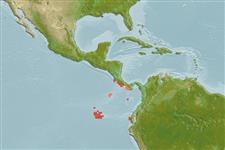Actinopterygii (ray-finned fishes) >
Perciformes (Perch-likes) >
Serranidae (Sea basses: groupers and fairy basslets) > Epinephelinae
Etymology: Epinephelus: Greek, epinephelos = cloudy (Ref. 45335).
Environment / Climate / Range
Ecology
Marine; demersal; depth range 40 - 120 m (Ref. 5222). Tropical, preferred ?; 10°N - 4°S, 92°W - 81°W (Ref. 5222)
Eastern Pacific: Galapagos Islands, Isla del Coco, and off Costa Rica. It probably occurs off Mexico. Galapagos Islands subpopulation is classified as vulnerable in the 2004 IUCN red list of threatened species (Ref. 53964).
Size / Weight / Age
Maturity: Lm ? range ? - ? cm
Max length : 100.0 cm TL male/unsexed; (Ref. 5222); max. published weight: 22.3 kg (Ref. 40637)
Dorsal
spines
(total): 11;
Dorsal
soft rays
(total): 14-16;
Anal
spines: 3;
Anal
soft rays: 9. Distinguished by the following characteristics: head and body pale brown, with distinct greenish sheen on the body; dark color of lips, tip of lower jaw and dorsal part of the body; brown fins, darker than body, with blue-green sheen; pelvic fins pale brown with dusky membranes; juveniles without distinctive markings except for a dark maxillary groove; body depth 2.6-3.0 times in SL; head length 2.5-2.8 times in SL; convex interorbital area, width greater than eye diameter; preopercle subangular, serrae at angle slightly enlarged; slightly convex upper edge of operculum; subequal nostrils or posterior nostril slightly larger; maxilla reaches past vertical through centre of eye; midside of lower jaw with two rows of teeth; truncate caudal fin with rounded corners in adults, convex in juveniles; midlateral body scales distinctly ctenoid, auxiliary scales in large adults (Ref. 089707).
Deep-water species found on rocky reefs in depths of 40-120 m (Ref. 089707). Marketed fresh (Ref.9342).
Life cycle and mating behavior
Maturity | Reproduction | Spawning | Eggs | Fecundity | Larvae
Heemstra, P.C. and J.E. Randall, 1993. FAO Species Catalogue. Vol. 16. Groupers of the world (family Serranidae, subfamily Epinephelinae). An annotated and illustrated catalogue of the grouper, rockcod, hind, coral grouper and lyretail species known to date. Rome: FAO. FAO Fish. Synop. 125(16):382 p. (Ref. 5222)
IUCN Red List Status (Ref. 115185)
CITES (Ref. 94142)
Not Evaluated
Threat to humans
Harmless
Human uses
Fisheries: highly commercial
More information
Common namesSynonymsMetabolismPredatorsEcotoxicologyReproductionMaturitySpawningFecundityEggsEgg development
ReferencesAquacultureAquaculture profileStrainsGeneticsAllele frequenciesHeritabilityDiseasesProcessingMass conversion
Tools
Special reports
Download XML
Internet sources
